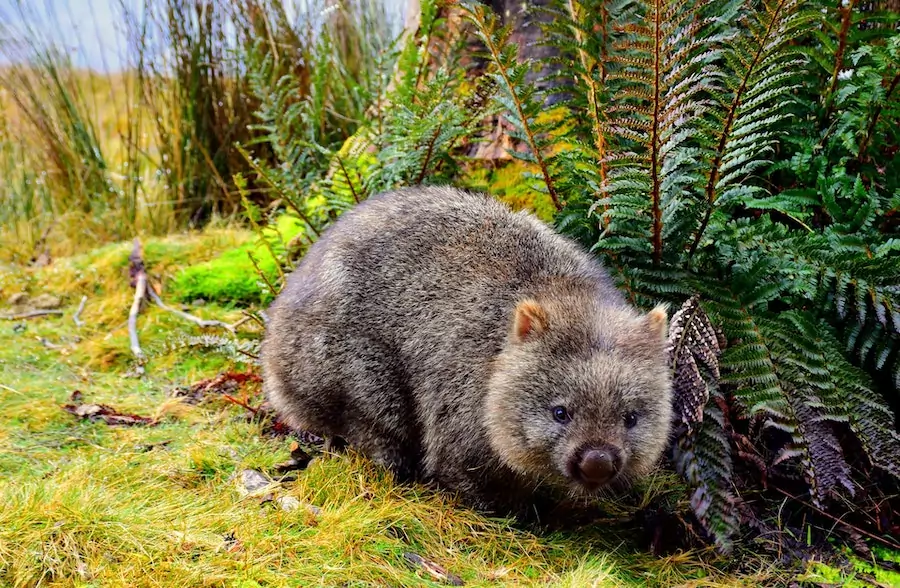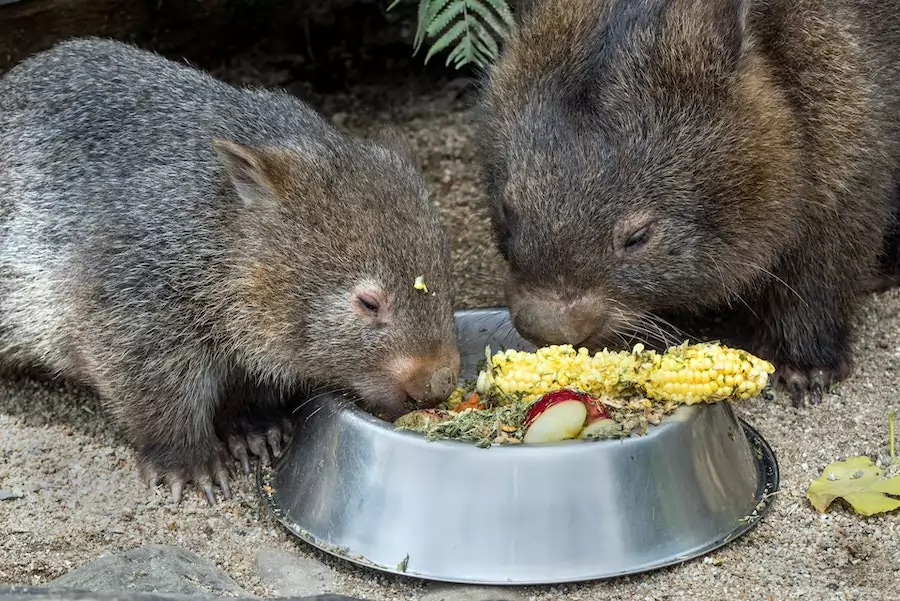It’s one of those occasions when you think, what do wombats eat? Well, that’s what we’re going to answer in this article.
Here’s the quick answer, then we’ll get into more details…
Wombats spend around 3 to 8 hours each night grazing mostly on native grasses. These include wallaby grass, tussocky ‘snow grass’, and kangaroo grass. They also feed on sedges and shrubs and tree roots. They bite through vegetation using sharp chiseled front teeth that continuously grow.
Wombats are herbivores and more specifically grazers, so most of their diet is made up of grasses.
Wombats also feed on a variety of vegetation but they don’t eat fruits or nuts.
They have a very limited eating pattern so tend not to forage for food for long, and can also function for weeks or even months without water.
Here are 20 amazing facts about wombats.
keep reading, or watch the video below from the Ranger Planet YouTube Channel.
A wombats general diet
Wombats are completely herbivores.
They are specifically known as grazers, but not necessarily granivores. They naturally make grass a huge portion of their diet.
The feeding range and the composition of a wombat’s diet will vary based on their species.
But in general, wombats feed a variety of grasses, sedges, forbs, roots, and bulbs. This general diet is very high in fiber and is low in nitrogen.
The quantity and quality of the food they eat are affected by seasonal variation, small home ranges, and the availability of food.
The majority of the water a wombat consumes comes directly from their food, being mostly moist grasses and succulent shrub roots.
Wombats also prefer younger and tender grass shoots, whenever they are available. And moss is also a favorite food among most wombats.
During times when food is scarce, like seasons such as drought and in winter, Wombats may resort to digging up up dead grass to get to the roots.
Many people misinterpret wombats as naturally feeding on insects, snails, worms, fish, and small invertebrates, but wombats would not eat this type of food.
This interpretation may come from wombats who might be seen attacking such creatures, which makes it look like they are feeding on them. But in truth, they don’t.
They would not accept fruits or nuts either. However, they will eat vegetables such as carrots, corn, cabbage, and lettuce which are among their favorite vegetation.
Because wombats are enthusiastic grazers, their teeth structure is adapted to support their eating patterns. A wombat’s teeth are rootless and will continue to grow despite being worn down by rough diet, chewing, and digging.

What do wombats eat – wombat nutrient and digestive system
Surprisingly, a wombat’s diet is nutritionally poor as it’s low in protein and high in fiber.
This compels them to conserve as much energy as possible. A primary method wombats use to conserve energy is by maintaining a very low metabolic rate.
When comparing the different wombat species, the southern hairy-nosed wombats have a significantly low metabolism. The food they consume passes through the digestive system slowly.
7-14 day digestion process
It generally takes between one and two weeks for this food to pass through a wombat’s digestive system.
This slow digestive process allows wombats to extract the maximum amount of nutrients from the grass and other foods.
Besides this, wombats also maintain a more efficient digestive system when compared to many other grazing animals such as sheep, cattle, and kangaroos.
They also eat very little in relation to their size.
Usually, wombats eat only one-third as much as a comparably sized kangaroo and a quarter as much as a sheep of a similar size.
This limited eating pattern provides them with the benefit of not having to spend a great deal of their time foraging.
Wombat feeding range
When it comes to their feeding range, they cover around 25-37 acres (10-20 hectares).
This feeding range can largely depend on the availability of food and the quality of food in that area.
If you consider a wombat’s limited feeding range, alongside their limited food intake, it perfectly complements their slow and time-consuming digestive process as well.
Water in a wombats diet
Water doesn’t make up a great part of a wombat’s diet.
Wombats limit their water loss to enable them to go for long periods without the need to drink water.
They also choose to stay in the burrow during the heat of the day, which helps them to prevent water loss.
They are mostly seen foraging for food at night, again this helps them to conserve water.
In general, for their size, wombats require less water than almost any other mammal. On average they only require 20% to 25% water compared to a sheep or kangaroo’s water requirements.
What do wombats eat in dry climates
Hairy-nosed wombats live in very dry climates. The only water they can realistically get is from the vegetation they consume. In many cases, they obtain their water intake from dew.
Their digestive system and diet patterns are naturally adapted to last for weeks and even months without drinking water.
They might only drink a lot more water after an abundance of rain.
In contrast, the common wombat species prefer drinking water frequently when it’s available.
What do wombats eat – based on wombat species
Let’s look in a bit more detail at the individual wombat dietary preferences by species.
Bare-nosed or Common wombat diet
Bare-nosed wombats, also known as common wombats, usually forage for food along the seashore.
Common wombats will sometimes eat farm vegetables, and when it comes to grass, they prefer snow tussocks and spear grass in woodlands. In open areas, they prefer to eat kangaroo grass and wallaby grass.
Cultivated oat crops also make a good meal for these species.
During food shortages or tough weather, they feed on carex species (Sedges) and Lomandra species (rushes). Common wombats will graze for about 3-8 hours per night.
Southern hairy-nosed wombat diet
When it comes to grass, hairy-nosed wombats feed on spear grass and also show a high preference for perennial grasses.
But because they have a somewhat broader diet, they might be considered as browsers.
They also feed on grassroots, herbs, plant roots, bushes, trees, fungi such as mushrooms and puffballs, shrubs, leaves, mosses, marsh plants, and tree bark, in particular, the inner bark of specific types of trees.
During any drought periods and when food is scarce, they will consider eating blue bush, bindi, forbs/dicots in grasslands, and woody shrubs in shrublands/woodlands.
Northern hairy-nosed wombat diet
The favorite type of grasses for this species of wombats are spear grass, tussock grass, and poa grass.
Weeping grass and reed bentgrass is a choice they opt for when sourcing food becomes challenging.
Three-awned grasses, bottlewasher grasses, and buffelgrass also make up a huge part of their diet in the wild.
The northern hairy-nosed wombats feed for about 2 hours each night during the summer season. In winter they feed for up to 6 hours.
During wet or monsoon seasons, their feeding range reduces to about 7.5 acres (3 hectares). In the dry seasons, this widens to 15 acres (6 hectares).
As the leaves and stems of grasses are more nutritious, these animals prefer them more – as it can keep them active for longer, complementing their limited eating pattern.
What do wombats eat in captivity
In captivity, a wombat diet does not alter much. They will still be looking to feed on a variety of grasses appropriate for their species as well as sedges, other shrubs, and wild vegetation. Commonly mixed in with a few vegetables in order to vary their diet intake.

What baby wombats eat
Newborn baby wombats will rely on their mother’s milk. So a mild milk solution may be possible for feeding a baby joey. Older babies may try to chew all kinds of items so they need guiding. They can be fed grass or rolled oats until they are old enough to forage for themselves.
However, if you find a baby wombat, it’s likely that it has been separated from its mother and may well be traumatized. For this reason, keep it warm and contact local wildlife services for assistance.
What animals do wombats eat?
As we mentioned previously, wombats are herbivores. At most, they are considered browsers. Even when food is scarce, they would seek other vegetation before eating animals. The only wildlife they may eat is accidental, as there may be bugs on the grasses and vegetation they consume.
Ever wondered if Koala Bears can be dangerous?
